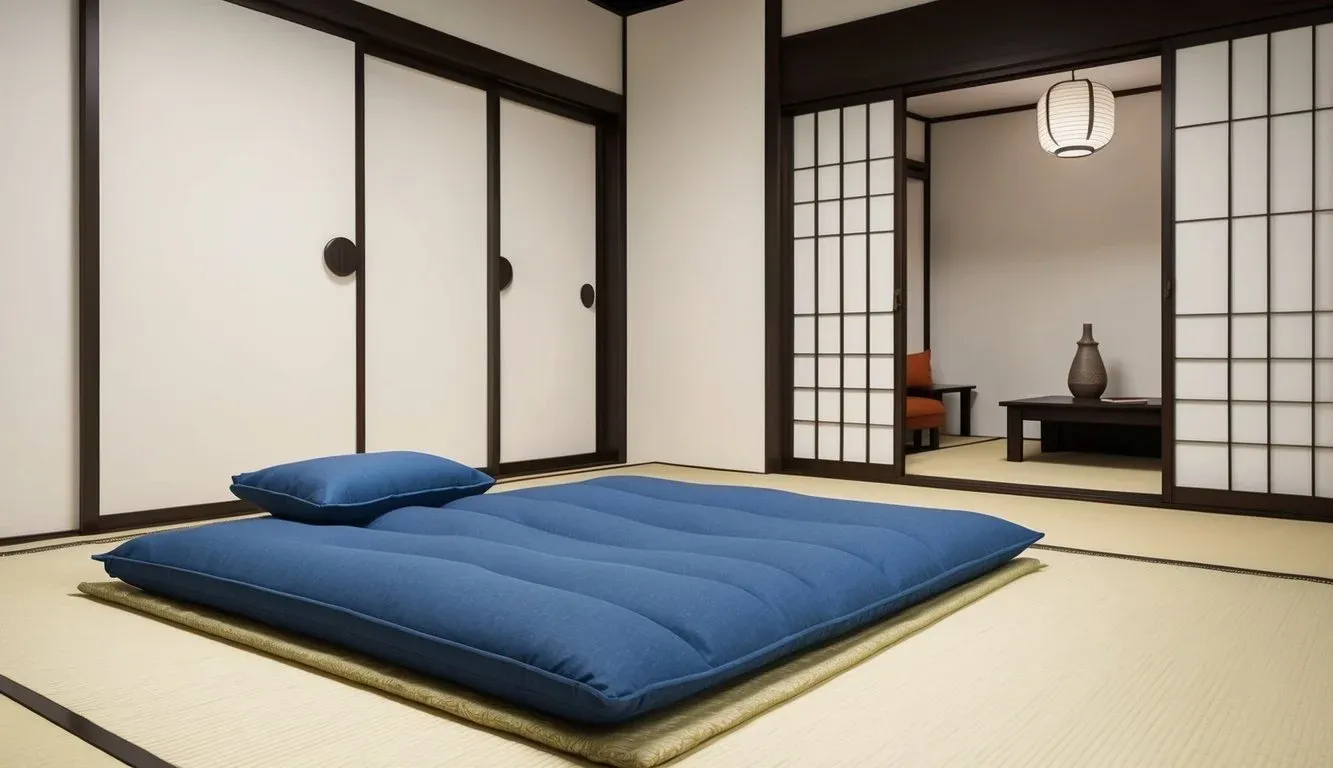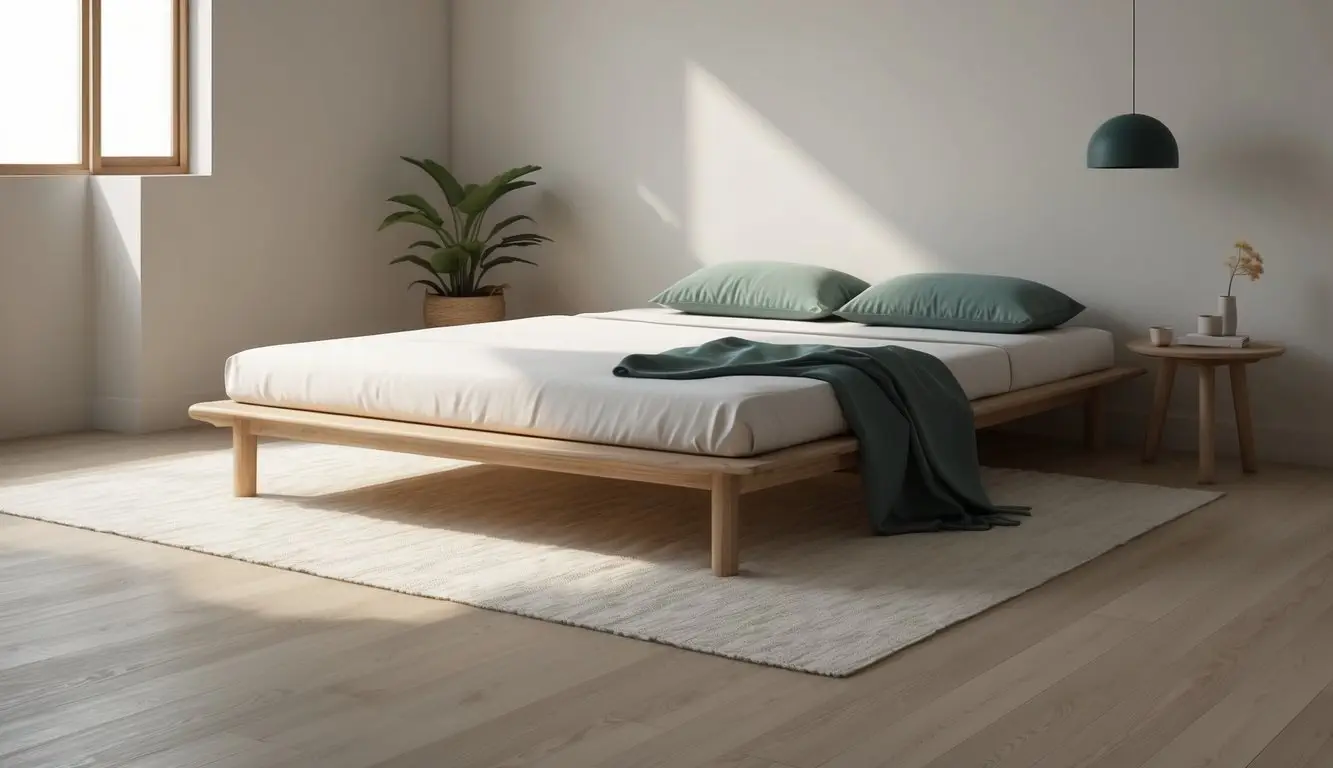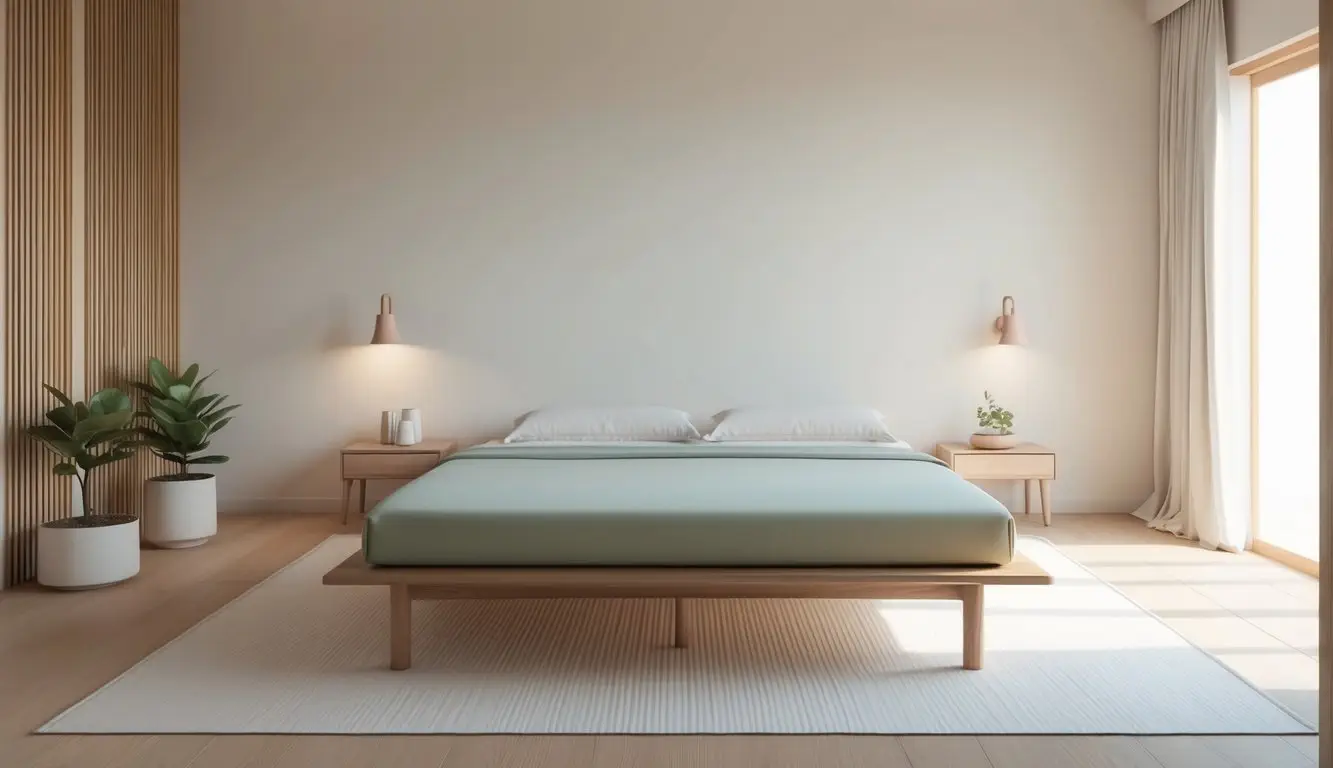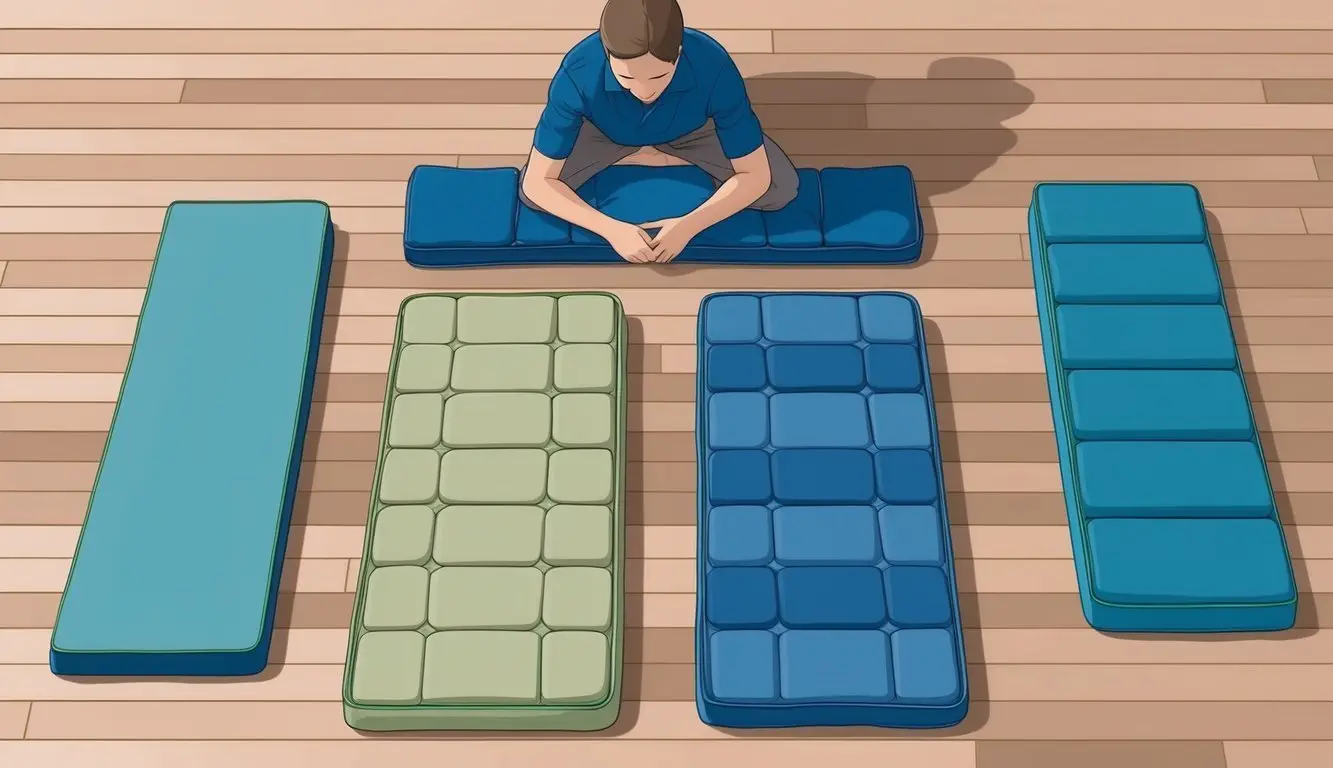Looking for the perfect blend of comfort and tradition in your sleep setup? A shikibuton mattress offers an authentic Japanese sleeping experience with modern benefits.

The best shikibuton mattress provides firm support while being flexible enough to fold and store during the day, making it ideal for small spaces. These traditional Japanese floor mattresses typically contain cotton, wool, or latex filling and come in various thicknesses to suit different comfort preferences.
When choosing a shikibuton, consider factors like material quality, thickness, and whether it needs to be paired with a tatami mat for optimal use. The right shikibuton can improve your sleep quality while adding minimalist style to your bedroom.
What Is a Shikibuton Mattress?

A shikibuton mattress is a traditional Japanese sleeping mat that provides firm support while remaining portable and space-efficient. These minimalist floor mattresses have a rich cultural history and are crafted using specific natural materials.
Historical Background
Shikibuton mattresses originated in Japan centuries ago as part of a minimalist approach to home furnishings. The word “shikibuton” combines “shiki” (to spread out) and “futon” (bedding), accurately describing its function as bedding that is laid out for sleeping.
During the Edo period (1603-1868), these mattresses became common in Japanese households. Families would roll up their shikibutons during the day to create more living space. This practice reflected Japanese values of simplicity and efficiency.
Unlike Western beds with bulky frames and box springs, shikibutons allowed Japanese homes to serve multiple purposes throughout the day. The mattresses were traditionally placed on tatami mats, which are woven straw floor coverings that provide additional cushioning.
Traditional Materials Used
Traditional shikibutons are made with cotton batting carefully layered inside a cotton cover. The cotton is compressed and tufted to create a firm, supportive surface that’s typically 3-4 inches thick.
Artisans hand-stuff these mattresses using long bamboo rods to ensure even distribution of the cotton filling. This technique prevents lumps and maintains consistent support throughout the mattress.
Some premium shikibutons incorporate:
- Natural wool for temperature regulation
- Silk batting for luxurious comfort
- Hemp covers for durability and breathability
Modern versions sometimes include latex, wool, or even memory foam layers while maintaining the traditional thin profile. Most authentic shikibutons avoid synthetic materials, focusing instead on breathable, natural fibers that adapt to Japan’s humid climate.
Benefits of Sleeping on a Shikibuton

Shikibuton mattresses offer several advantages that make them a smart choice for many sleepers. These traditional Japanese floor mattresses combine comfort with practicality in ways that conventional mattresses cannot match.
Health and Orthopedic Advantages
Shikibutons provide firm support that promotes proper spinal alignment. Many users report reduced back pain after switching from soft mattresses to these firmer alternatives.
The natural materials commonly used in shikibutons, such as cotton and wool, allow for better air circulation. This improved breathability helps regulate body temperature and reduces night sweats.
Some chiropractors recommend shikibutons for patients with certain back conditions. The firm surface encourages proper posture during sleep without creating pressure points.
Sleeping closer to the ground may also improve blood circulation. This position requires more movement to get up and down, which can increase daily physical activity.
Suitability for Minimalist Lifestyles
Shikibutons align perfectly with minimalist philosophies by eliminating bulky bedroom furniture. They remove the need for bed frames, box springs, and heavy mattresses.
Their simple design reflects the minimalist principle of keeping only what serves a purpose. A shikibuton can be the centerpiece of a clutter-free sleeping area.
Cost efficiency is another benefit for minimalists. Shikibutons typically cost less than traditional mattress sets while lasting for many years with proper care.
The versatility of these mattresses allows one piece of furniture to serve multiple functions. During the day, a folded shikibuton becomes seating or can be stored away completely.
Ease of Storage and Space Efficiency
Shikibutons can be folded or rolled when not in use, making them ideal for small living spaces. This feature is particularly valuable in apartments or tiny homes.
A typical shikibuton takes up about 70% less storage space than a conventional mattress. Some models fold into thirds for even more compact storage.
Storage options include:
- Wall closets
- Storage chests
- Under raised platforms
- Behind furniture
The ability to reconfigure living spaces throughout the day makes shikibutons perfect for multipurpose rooms. A bedroom can transform into a home office or exercise space within minutes.
For travelers or those who move frequently, shikibutons offer unmatched portability. They can be transported in most vehicles without requiring special moving services.
Selecting the Best Shikibuton Mattress

Finding the right shikibuton requires careful consideration of several key factors. The perfect mattress balances firmness, quality materials, and appropriate dimensions for your specific needs and sleeping style.
Understanding Firmness and Support
Shikibuton firmness directly impacts sleep quality and body alignment. Traditional Japanese shikibutons tend to be firmer than Western mattresses, offering solid support for the spine.
Firmness preferences vary based on sleeping position. Side sleepers typically benefit from slightly softer shikibutons that cushion shoulder and hip pressure points. Back and stomach sleepers often prefer firmer options that prevent excessive sinking.
Some manufacturers use a firmness scale from 1-10, with most shikibutons falling between 6-8. This medium-firm to firm range provides balanced support while still conforming to the body.
Weight is another important consideration. Heavier individuals (over 200 pounds) should select firmer, denser shikibutons to prevent excessive compression and maintain proper support.
Material Quality and Durability
Cotton remains the most traditional and breathable material for shikibuton covers. Organic cotton options minimize chemical exposure and are ideal for those with sensitive skin.
Core Materials:
- Cotton: Lightweight, breathable, and traditionally authentic
- Wool: Natural temperature regulation and moisture-wicking properties
- Latex: Excellent durability, responsiveness, and natural resistance to dust mites
- Foam: Offers pressure relief but less traditional
The best shikibutons use layered construction with different materials. This creates balanced support and extends the mattress lifespan.
Quality stitching with reinforced edges prevents filling from shifting over time. Look for double-stitched or bound edges as indicators of durability.
Size and Thickness Variations
Shikibutons come in standard Western mattress sizes but may also be found in traditional Japanese dimensions.
Common Sizes:
| Size | Dimensions (inches) | Best For |
|---|---|---|
| Twin | 39 × 75 | Single adults, children |
| Full | 54 × 75 | Couples with limited space |
| Queen | 60 × 80 | Most couples |
| King | 76 × 80 | Couples needing extra space |
Thickness typically ranges from 3-6 inches. Thinner options (3-4 inches) offer a more authentic experience but may feel too firm for those new to floor sleeping.
Thicker shikibutons (5-6 inches) provide more cushioning and are better suited for Western users transitioning from conventional mattresses. These hybrid options balance traditional design with additional comfort.
Caring for Your Shikibuton

Proper maintenance extends the life of your shikibuton and keeps it comfortable for years to come. Regular care prevents mold growth, maintains the shape, and preserves the natural materials.
Daily Maintenance Tips
Fold your shikibuton every morning or roll it up when not in use. This practice prevents moisture buildup and helps maintain its shape. Japanese tradition suggests storing it in a well-ventilated closet or on a rack.
Air it out regularly. Place your shikibuton in direct sunlight for 2-3 hours once a week. Sunlight naturally disinfects the mattress and prevents mold growth.
Rotate your shikibuton once a month to ensure even wear. Flip it top to bottom and side to side for the best results.
Use a protective cover that can be easily removed and washed. This barrier keeps the inner materials clean and extends the time between deep cleanings.
Beat your shikibuton with a bamboo stick or tennis racket occasionally to remove dust and restore fluffiness.
Cleaning and Washing Instructions
Most shikibutons cannot be machine washed due to their size and materials. Always check the manufacturer’s care label before cleaning.
Spot cleaning works best for small stains:
- Mix mild detergent with warm water
- Dab the stain gently without soaking the mattress
- Allow it to dry completely before use
For deeper cleaning, professional services specializing in Japanese bedding are recommended. Some companies offer shikibuton washing services with specialized equipment.
If washing at home is necessary, use a bathtub with gentle detergent and rinse thoroughly. Never wring out a shikibuton; press it between towels instead. Dry it completely in the sun, turning several times.
Deodorize naturally by sprinkling baking soda across the surface, letting it sit for several hours, then vacuuming thoroughly.
Integrating a Shikibuton into Your Home

A shikibuton mattress offers flexibility in home design while providing authentic Japanese-style comfort. It can transform any space into a functional sleeping area or daytime lounge depending on your needs.
Ideal Room Configurations
Shikibutons work well in small apartments where space is limited. They can be rolled up and stored in a closet during the day, freeing up floor space for other activities.
In studio apartments, pair your shikibuton with a low platform or tatami mats for proper air circulation. This combination creates a designated sleeping zone without permanent furniture.
For multipurpose rooms, place your shikibuton against a wall with floor pillows during the day to create a comfortable seating area. This setup works particularly well in home offices or guest rooms.
Consider room humidity and ventilation when positioning your shikibuton. Avoid placing it directly on carpet or in damp areas to prevent mold growth and maintain mattress longevity.
Complementary Bedding Options
Essential accessories for your shikibuton include:
- A waterproof mattress protector
- Cotton sheets (preferably fitted with deep pockets)
- A lightweight comforter or kakebuton
- Buckwheat or memory foam pillows
Traditional Japanese bedding pairs well with shikibutons. Consider adding a shams cushion for back support when using your shikibuton as daytime seating.
For changing seasons, layer accordingly. Use breathable cotton covers in summer and add a wool mattress pad underneath for winter warmth.
Storage solutions such as decorative fabric bags or benches with compartments keep your bedding organized when not in use. These practical options maintain the minimalist aesthetic typical of spaces featuring shikibutons.
Top Shikibuton Mattress Brands

Several reputable manufacturers have established themselves in the shikibuton market, with distinct differences between traditional Japanese craftsmanship and Western adaptations. Brand selection often determines the authenticity, materials, and overall sleep experience.
Traditional Japanese Brands
J-Life offers authentic cotton-filled shikibutons handcrafted using traditional methods. Their mattresses contain 100% natural materials with no synthetic fillers or chemicals.
Emoor produces high-quality shikibutons that balance tradition with modern needs. Their signature Classe series features anti-bacterial and anti-dust mite treatments while maintaining traditional construction.
Fuli features mattresses made with premium long-staple cotton that maintains shape longer than standard cotton. They’re known for their three-layer design that provides better support than single-layer alternatives.
Ikehiko stands out with their igusa (rush grass) shikibutons that offer natural cooling properties. These mattresses incorporate traditional tatami materials for enhanced breathability during hot weather.
Western Interpretations
Tuft & Needle’s shikibuton-inspired floor mattress combines Japanese minimalism with American foam technology. Their design uses CertiPUR-US certified foam instead of traditional cotton batting.
The Futon Shop produces organic shikibutons that meet Western safety standards. They offer customizable firmness levels and thickness options not typically found in traditional versions.
Organic Textiles creates eco-friendly shikibutons using GOTS-certified cotton. Their mattresses feature removable, machine-washable covers—a practical Western addition to the traditional design.
Sunrising Bedding incorporates memory foam layers into their shikibuton-style mattresses. This hybrid approach aims to blend Japanese simplicity with Western comfort expectations.
Customer Reviews and Experiences

Real customers often provide the most valuable insights when choosing a shikibuton mattress. Many reviewers praise these traditional Japanese mattresses for their firmness and support.
One common theme in positive reviews is versatility. Customers appreciate being able to fold and store their shikibuton during the day, creating more usable space in small apartments.
“The firm support helped my back pain significantly,” notes one reviewer who switched from a conventional spring mattress. Many users with back issues report similar experiences.
Some customers mention an adjustment period. The firmness can be surprising at first, especially for those accustomed to plusher Western mattresses.
Top Mentioned Benefits in Reviews:
- Durability: Many last 5+ years with proper care
- Natural materials: Cotton and wool options appreciated by eco-conscious buyers
- Portability: Easy to move between rooms or homes
- Space-saving: Ability to fold and store during the day
Common criticisms include the need for regular airing out and the initial firmness. Some users add a thin topper for extra comfort while maintaining support.
First-time buyers often mention surprise at the thinness compared to conventional mattresses. However, most adapt quickly to the different sleep experience.
Reviews suggest cotton shikibutons are preferred in warmer climates, while wool blends receive higher ratings in cooler regions due to their temperature regulation properties.
Sustainability and Eco-Friendliness

Shikibuton mattresses often rank high on the eco-friendly scale due to their natural materials and minimal processing. Many manufacturers use organic cotton, wool, and natural latex without harmful chemicals or flame retardants.
Traditional Japanese shikibutons typically feature cotton filling, one of the most sustainable bedding materials when grown organically. Some modern versions incorporate materials like organic wool, which provides natural fire resistance without chemical additives.
Key Eco-Friendly Benefits:
- Biodegradable materials
- Lower carbon footprint (compared to synthetic mattresses)
- Reduced off-gassing and indoor air pollution
- Longer lifespan when properly maintained
Most shikibutons can be rolled and stored when not in use, saving space and reducing the need for additional furniture. This multifunctional aspect aligns with minimalist and sustainable living philosophies.
When shopping for an eco-friendly shikibuton, look for certifications like GOTS (Global Organic Textile Standard) or OEKO-TEX. These ensure the materials meet strict environmental and social criteria.
Companies like Organic Lifestyle and J-Life International have pioneered sustainable shikibuton options in the Western market. Their products often feature hand-crafted construction and responsibly sourced materials.
The simple design of shikibutons means fewer resources are used in manufacturing compared to conventional mattresses with complex spring systems and synthetic foams.
Pricing and Value

Shikibuton mattresses typically cost between $200 and $800, depending on size, materials, and craftsmanship. This price range makes them more affordable than many traditional mattresses, which can easily exceed $1,000.
Pure cotton shikibutons tend to be less expensive, often ranging from $200 to $400 for a queen size. These provide good basic comfort but may compress more quickly over time.
Wool-cotton blends and organic options usually fall in the $400 to $600 range. These materials offer better durability and temperature regulation, making them worth the extra investment for many buyers.
Premium shikibutons with organic cotton, wool, and latex can reach $600 to $800. While more expensive, these high-quality materials often last 5-8 years with proper care.
Value Considerations:
- Longevity: With regular rotation and airing, a quality shikibuton can last 5-10 years
- Versatility: Can be folded and stored when not in use, saving space
- Portability: Easy to move between rooms or homes
- No box spring needed: Saves on additional furniture costs
Many manufacturers offer warranties ranging from 1-5 years, adding value to your purchase. Purchasing a protective cover ($30-$70) is highly recommended to extend the life of the mattress.
When comparing prices, remember that shikibutons require a firm surface underneath, such as tatami mats or a platform bed. These additional costs should be factored into the overall value assessment.
Frequently Asked Questions
Consumers often have specific concerns when shopping for a shikibuton mattress. These questions address comfort, materials, selection criteria, and cultural aspects of these traditional Japanese sleeping mats.
What are the health benefits of using a shikibuton for sleep?
Shikibuton mattresses provide firm support that helps maintain proper spinal alignment during sleep. This firmness can reduce back pain and improve posture over time.
Many users report fewer pressure points compared to spring mattresses, leading to less tossing and turning at night. The natural materials used in quality shikibutons also promote better air circulation.
People with allergies often benefit from shikibutons because they gather less dust and can be easily aired out regularly. The simplicity of sleeping closer to the floor also encourages better blood circulation for some sleepers.
Which materials are considered the best for a comfortable shikibuton mattress?
Cotton remains the gold standard for shikibuton filling, offering a balance of support and breathability. High-grade cotton provides firmness while still conforming to the body’s contours.
Wool-filled shikibutons excel in temperature regulation, keeping sleepers warm in winter and cool in summer. Wool also has natural moisture-wicking properties that help maintain comfort through the night.
For those seeking additional cushioning, some manufacturers offer shikibutons with layers of natural latex. These hybrid options provide more give while maintaining the traditional low profile.
How do I select the right shikibuton for my needs?
Consider your preferred sleeping position when choosing thickness. Side sleepers typically need thicker shikibutons (3-4 inches) for proper hip and shoulder support, while back sleepers might prefer thinner options.
Body weight also affects the ideal firmness level. Heavier individuals generally benefit from denser materials that prevent bottoming out during sleep.
Test the mattress whenever possible before purchasing. A quality shikibuton should feel firm but not hard, with enough give to prevent pressure points while supporting your body.
Are futon beds from Japan superior to Western-style mattresses?
Japanese shikibutons and Western mattresses serve different purposes rather than one being inherently superior. Shikibutons excel in space efficiency, portability, and firm support.
Traditional shikibutons typically contain fewer synthetic materials than many Western mattresses. This appeals to consumers seeking more natural sleeping surfaces with fewer potential chemicals.
The cultural context matters significantly. Japanese sleeping traditions emphasize minimalism and flexibility, while Western bedding often prioritizes plushness and permanent bedroom fixtures.
What should I look for when reading reviews about Japanese futon mattresses?
Pay attention to comments about durability and maintenance requirements. Quality shikibutons should last 5-10 years with proper care, including regular folding and airing out.
Reviews mentioning firmness levels provide valuable insights, but remember that comfort preferences are subjective. One person’s “too firm” might be another’s “perfect support.”
Look for reviews from people with similar sleeping styles and body types as yours. Their experiences will likely be more relevant to your potential satisfaction with the product.
Are Japanese futon mattresses still commonly used in Japan today?
Japanese futons remain widely used in traditional homes across Japan, especially in areas where living space comes at a premium. Many Japanese families maintain this sleeping tradition for its practicality.
Modern Japanese households often blend Western and traditional elements, with some using shikibutons on platform beds rather than directly on tatami floors. This hybrid approach preserves space-saving benefits while adding convenience.
In urban apartments, the practice of storing bedding during the day continues, though some younger Japanese now choose Western-style beds. Cultural shifts have influenced sleeping habits, but shikibutons maintain significant cultural relevance.